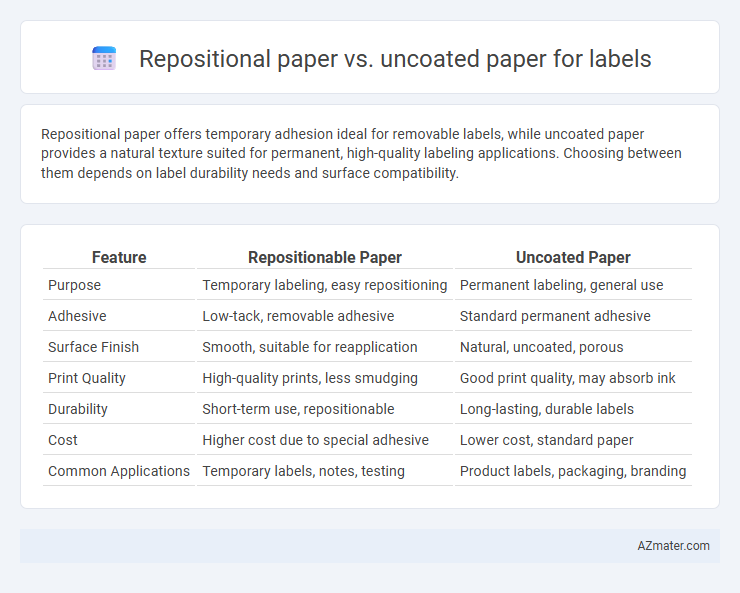Repositional paper offers temporary adhesion ideal for removable labels, while uncoated paper provides a natural texture suited for permanent, high-quality labeling applications. Choosing between them depends on label durability needs and surface compatibility.
Table of Comparison
| Feature | Repositionable Paper | Uncoated Paper |
|---|---|---|
| Purpose | Temporary labeling, easy repositioning | Permanent labeling, general use |
| Adhesive | Low-tack, removable adhesive | Standard permanent adhesive |
| Surface Finish | Smooth, suitable for reapplication | Natural, uncoated, porous |
| Print Quality | High-quality prints, less smudging | Good print quality, may absorb ink |
| Durability | Short-term use, repositionable | Long-lasting, durable labels |
| Cost | Higher cost due to special adhesive | Lower cost, standard paper |
| Common Applications | Temporary labels, notes, testing | Product labels, packaging, branding |
Introduction to Label Paper Types
Repositionable paper offers temporary adhesion, allowing labels to be removed and reapplied without residue, making it ideal for short-term labeling and repositioning tasks. Uncoated paper, characterized by its natural, porous surface, provides excellent printability and writeability, favored for labels needing direct marking or eco-friendly options. Choosing between repositionable and uncoated paper depends on the label's application, durability requirements, and surface interaction needs.
What is Repositional Paper?
Repositional paper is a type of label stock designed for temporary placement and easy removal without leaving adhesive residue, making it ideal for samples, price tags, and promotional stickers. Unlike uncoated paper, which lacks a glossy finish and is more absorbent, repositional paper features a low-tack adhesive that allows labels to be repositioned multiple times. This functionality enhances flexibility in labeling applications, providing both convenience and durability in dynamic retail or office environments.
Characteristics of Uncoated Paper
Uncoated paper for labels exhibits a natural, matte finish with excellent absorbency, making it ideal for inkjet printing and handwritten applications. Its porous surface enhances adhesion for various adhesives but tends to absorb more ink, which may result in less vibrant colors compared to repositional paper. This paper type offers superior recyclability and eco-friendliness due to the absence of coatings and chemical treatments commonly found in repositional paper.
Adhesion Properties: Repositional vs Uncoated
Repositional paper offers moderate adhesion, allowing labels to be easily removed and repositioned without leaving residue, making it ideal for temporary labeling applications. Uncoated paper provides stronger adhesion due to its porous surface, ensuring labels stick firmly and resist peeling, suitable for long-term use. The choice between repositional and uncoated paper depends on whether label removability or durability is the priority in label application.
Print Quality Comparison
Repositionable paper labels offer superior print quality with enhanced ink absorption and sharper image resolution compared to uncoated paper labels, which tend to absorb ink unevenly and produce duller prints. The smooth surface of repositionable paper facilitates consistent toner and ink distribution, resulting in vibrant colors and crisp text essential for high-detail labels. Uncoated paper, while better for cost-efficiency and eco-friendliness, often compromises print sharpness and durability, making repositionable paper the preferred choice for premium label printing requiring optimal clarity.
Durability and Resistance Analysis
Repositional paper labels offer moderate durability with adhesive designed for easy removal and repositioning, making them suitable for temporary labeling applications. Uncoated paper labels exhibit higher resistance to abrasion, moisture, and general wear due to their untreated surface, enhancing durability for long-term use. The choice between repositional and uncoated paper labels depends on the required balance between removability and resistance to environmental factors.
Best Use Cases for Repositional Paper
Repositional paper is ideal for temporary labeling, product samples, or promotional stickers where easy removal and repositioning without residue are crucial for user experience. It provides strong initial adhesion with low final tack, making it suitable for indoor applications like price tags, inventory labels, and event badges. Unlike uncoated paper, repositional paper maintains print clarity and directional repositioning capabilities, optimizing efficiency in supply chain and retail environments.
Ideal Applications for Uncoated Paper
Uncoated paper is ideal for labels requiring excellent printability and a natural, matte finish, commonly used in branding for products like food items, cosmetics, and artisanal goods. Its porous surface absorbs inks well, making it suitable for high-quality graphics and detailed text that demand a premium, eco-friendly appearance. Uncoated paper labels are preferred in applications where tactile appeal and environmental sustainability are prioritized over repositionability or adhesive flexibility.
Environmental Impact and Sustainability
Repositional paper for labels typically incorporates adhesive formulations that allow easy removal and reuse, reducing label waste and promoting recyclability compared to traditional uncoated paper. Uncoated paper labels are often biodegradable and compostable, contributing positively to sustainability efforts by minimizing environmental pollution and facilitating natural decomposition. Both materials vary in environmental impact depending on sourcing, production energy use, and end-of-life disposal, with repositional paper offering advantages in label reuse while uncoated paper excels in biodegradability.
Cost Considerations and Final Recommendations
Repositional paper often incurs higher initial costs due to its specialized adhesive technology, making it suitable for applications that require temporary labeling and easy removability. Uncoated paper is generally more cost-effective, offering a lower price point ideal for permanent labels where durability and straightforward adhesion are priorities. For budget-sensitive projects prioritizing permanence, uncoated paper is recommended, while repositional paper suits flexible labeling needs despite the higher cost.

Infographic: Repositional paper vs Uncoated paper for Label
 azmater.com
azmater.com